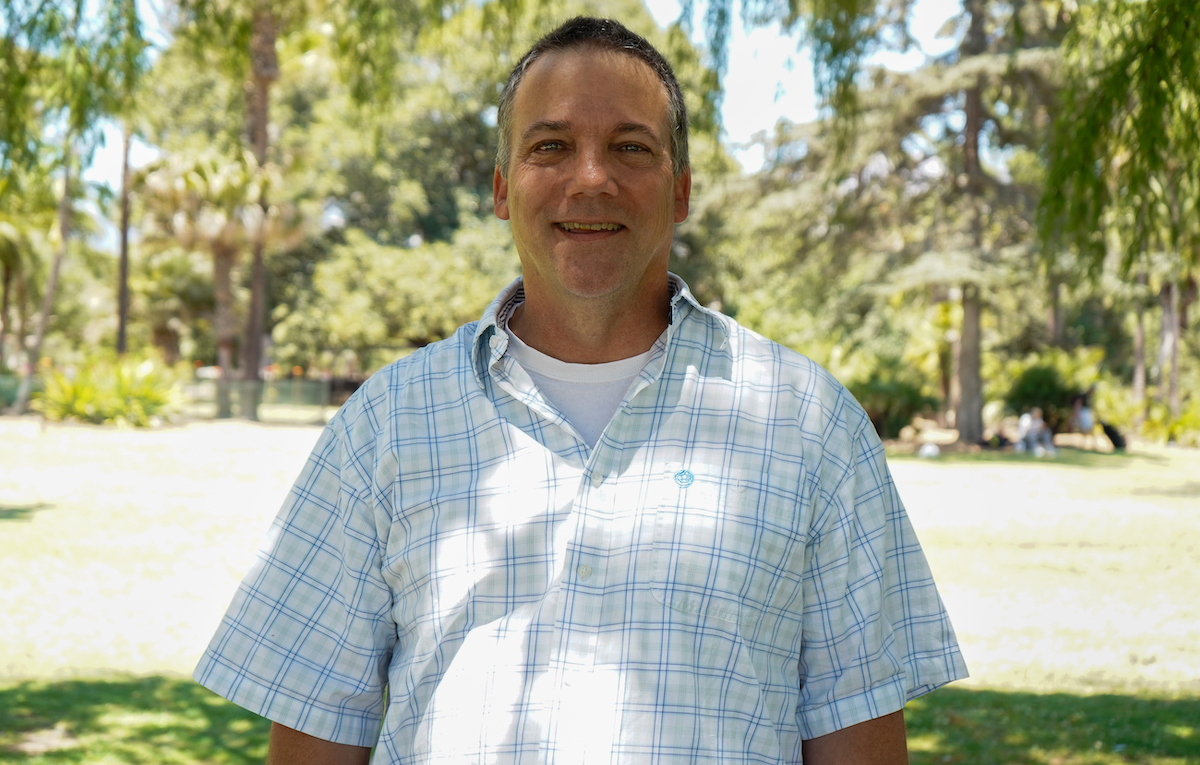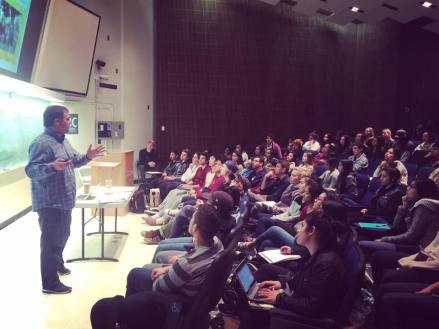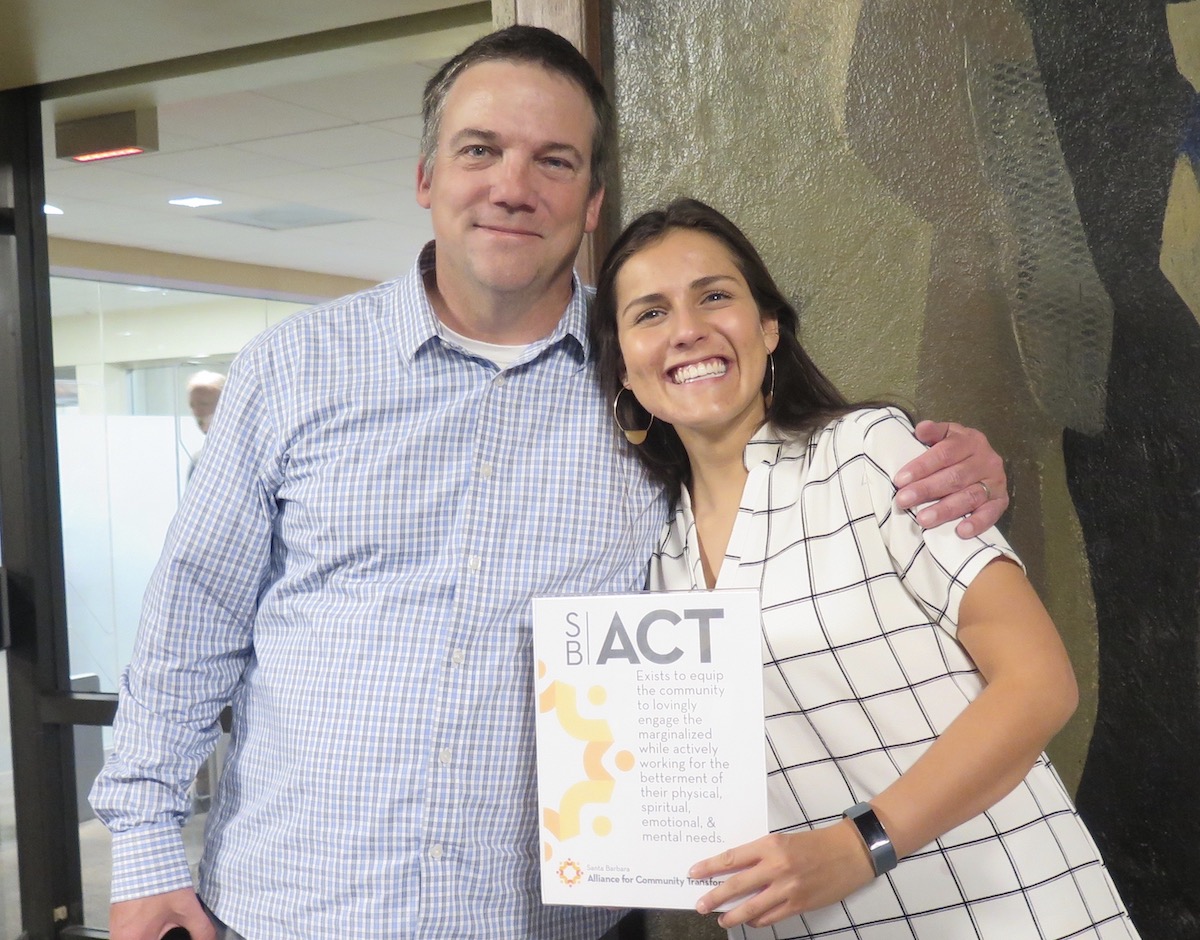Jeff Shaffer Got the 20-Year Itch — Again
Longtime Homeless Advocate Shifting from Santa Barbara Streets to Westmont Campus

Every 20 years or so, Jeff Shaffer gets an itch. For the last two decades, he has been the most visible face forward for S.B. ACT — also known as Santa Barbara Alliance for Community Transformation — a super-group focusing on solving society ills. Shaffer has relentlessly, but quietly, pushed the powers-that-be toward more compassionate responses and effective solutions for those living in town without roofs over their heads. But that’s all about to change.
As of September 1, Shaffer will start a new gig as activist-mentor and cheerleader-in-chief for Westmont students seeking to harness their youthful, moral passion on behalf of the poor and marginalized. He’ll be collaborating with Brad Fieldhouse of Kingdom Causes — a faith-based nonprofit out of Orange County — who also runs CityNet, a homeless outreach nonprofit.
During his first 20 years, Shaffer, a class clown growing up in the San Diego area, wanted to be a stand-up comedian and screenwriter. Then he found religion and became a minister here in Santa Barbara. That came to an end at age 40, when his congregation gave him the boot because of his emphasis on social justice issues.

Not long after, Shaffer started showing up at Pershing Park armed with a big pot of spaghetti, ready to dish it out to the homeless people who congregate there under the trees. The memory of the warm, friendly welcome he received then is still fresh and visceral. Soon after those spaghetti gatherings in 2005, Shaffer sought to repay their generosity of spirit by creating a well-orchestrated safe space every Thursday evening.
It evolved organically, beginning in Alameda Park where people without homes are able to get a free meal; take a hot shower; talk to a doctor; get pet food, supplies, grooming, and flea treatment; and otherwise enjoy the company of people — more than a few being students from Westmont. Depending on the weather and season, maybe 50-70 people show up.
At some point, Shaffer began dubbing these gatherings a “Neighborhood Navigation Center.” Two years ago, he, with the two other S.B. ACT leaders, Rich Sander and Barbara Andersen, opened more gathering places — one on Tuesday afternoons at the commuter parking lot by Castillo and Carrillo Streets; the other inside the Santa Barbara Rescue Mission on Wednesday mornings.
These centers, he believes, have a deeper strategic purpose. They are a key to building trust with people for whom trust is a scarce commodity. People who have been convinced they don’t need help might be persuaded to have second thoughts. As rooms become available, some move indoors. Out of such small steps, lives are changed.
THE QUIET MAN

In person, Shaffer is low-key almost to the point of subdued. His eyes are puffy with exhaustion yet sparkle with humor. He’s not inclined to pound tables or call names. He is, however, resolute. Above all, he shows up; he is there. When it comes to listening, he’s truly gifted. And when Shaffer listens, people talk. Crucially, it works the other way, too. That’s how Shaffer has managed to be so quietly effective.
He lives in Buellton with his wife, with whom he’s had three kids. His office is his cell phone and whatever coffee shop he happens to be near. A Christian, his faith is central to who Shaffer is. But it’s not something he broadcasts.
When he and Rick Sander formed S.B. ACT in 2013, they brought together big-brained, big-hearted, socially conscious advocates. They secured funding from many local philanthropies and more recently from City Hall. With Barbara Andersen, they formed a leadership troika that brought together a dedicated group working on a range of issues besides homelessness — immigration problems, refugee protection, health care disparities, and human trafficking.
In a recent interview, Sander said that he and Shaffer share a common world view but bring different skills to the table. Both came from the ministry. Both had wished their respective congregations had gotten more involved in social justice. But Sander explained, “My strength was always big system thinking. How do we create fundable programs? How to sustain them?” On the other hand, he said, Shaffer was the guy who got things started. “He was the boots-on-the-ground visionary. He built great relationships. He started new projects. When it came to the work, he was a true believer. He was never a paycheck kind of guy.”
Sharon Byrne, now with the Montecito Association, was a major player on Milpas Street not so many years ago. She worked with Shaffer on a project in 2014 identifying the 10 most chronically homeless people needing help — and causing a ruckus — along the Milpas Corridor. By finding out who generated the most calls for service, they could work to get them off the street, get them the services they needed, and ultimately get them into housing. The effort involved an unlikely combination of hard-nosed business people who just wanted homeless people to disappear and feel-good social service providers, like Shaffer, who believed more in second chances than accountability.

“Jeff figured out you get people around the table when you get them to be part of the solution instead of just complaining all the time,” Byrne said. “He should be credited with a lot of the changes that have happened since then. He took us from the time when what we needed was a homeless shelter to needing a coordinated system for getting these people care. I’d say about 98 percent of these changes have been Jeff.”
Sign up for Indy Today to receive fresh news from Independent.com, in your inbox, every morning.
CHANGING THE WEATHER

Minimizing the hostility against homeless populations around the city was one of Shaffer’s major goals. To do this, he structured a plan that divided Santa Barbara into different regional groups — the downtown, the waterfront, and the Eastside. Then he formed a Regional Action Plan, otherwise known as RAP, for each district. Shaffer and other organizers with S.B. ACT hosted regular weekly meetings — almost all on Zoom — in which neighbors, business people, and city officials upset about the homeless population got to speak their minds to people providing direct services to that population. Some homeless representatives — working with S.B. ACT — showed up as well.
Things could and did get hot during those meetings. To the extent anyone was assigned the role of peacemaker, it fell to Shaffer. When NIMBYs would become unglued about hypothetical harm that might befall their children, Shaffer never questioned their compassion. He quietly listened. “No one wants to be impacted by homelessness,” he acknowledged.
If neighbors and hotel owners were to embrace uncomfortable solutions — to switch sides — Shaffer recognized, they had to feel heard. For that to occur, he had to remain heroically neutral. Over time, those RAP meetings dwindled in both size and intensity. Shaffer regarded that as further evidence progress has been made.
Being neutral was not always easy. That’s one of the reasons Shaffer’s moving on. “For me, the ability to have a freer voice will be a good thing,” he said of his new incarnation with Westmont students. “I will be able to align with the marginalized a little bit more.”
Right now, Mayor Randy Rowse and the City Administration are pushing Shaffer to find someplace other than Alameda Park to hold the Neighborhood Navigation Center. Families and kids don’t mix well with the homeless people, he’s been told. Shaffer has agreed to look elsewhere, but he has steadfastly not agreed to move unless an alternate site makes sense.
He’s not been shy about expressing such concerns. “If we had a day center, that might be an option,” he said. “But we don’t. Everyone is forever pushing the homeless somewhere else. But not giving people the option to be anywhere is not a good option. And I think people in the street are put in that position. That’s not where we as a society want to be.”
Shaffer’s colleagues knew he was hoping to shift gears for a while, so his departure came as no surprise. A two-month search led to S.B. ACT hiring Katherine Soto-Vasquez, who has six years of experience working at the PATH homeless shelter on Cacique Street as front-line case manager and as associate director of programming.
One way or the other, Shaffer figures he’ll continue to work closely with S.B. ACT. “S.B. ACT needs to be in the room. It needs to be part of the picture.”

HAS ANYTHING REALLY CHANGED?
In the eyes of some observers, nothing’s changed. Santa Barbara had too many people living on the streets 20 years ago, and they have too many now. Shaffer sees it differently.
“When I started, we had no homeless shelter at all. We had no CityNet doing outreach; there was no Good Samaritan [a North County–based homeless shelter that offers a constellation of services] in Santa Barbara. There was no … reliable data to measure the problem, no Vulnerability Index to determine who needs help most immediately. There was no ‘team’ approach. We had no neighborhood navigation centers either. All that’s changed,” he said. “But we still need more shelter beds.”
Through S.B. ACT, he has worked closely with Westmont College students for a long time; two have already taken leadership roles with the organization working on homelessness and human trafficking issues. “I want to raise up a new generation of leaders and activists,” he explained. “I want to bring students more into the picture. Westmont students want to make a difference.”
What Shaffer does next will soon become clear. How he does it will soon become clear as well. Whatever and however that is, Shaffer said, he’s hoping his new position offers greater latitude. As he notified his new “boss,” Brad Fieldhouse, “I need a long leash.”
CORRECTION: The Point in Time count preceded Jeff Shaffer’s involvement. Also, C.A.R.E.4Paws does not provide veterinary services at the Alameda Park event but does on Thursdays at the Santa Barbara Eagles Club from 10 a.m. to 1 p.m.
Support the Santa Barbara Independent through a long-term or a single contribution.




You must be logged in to post a comment.